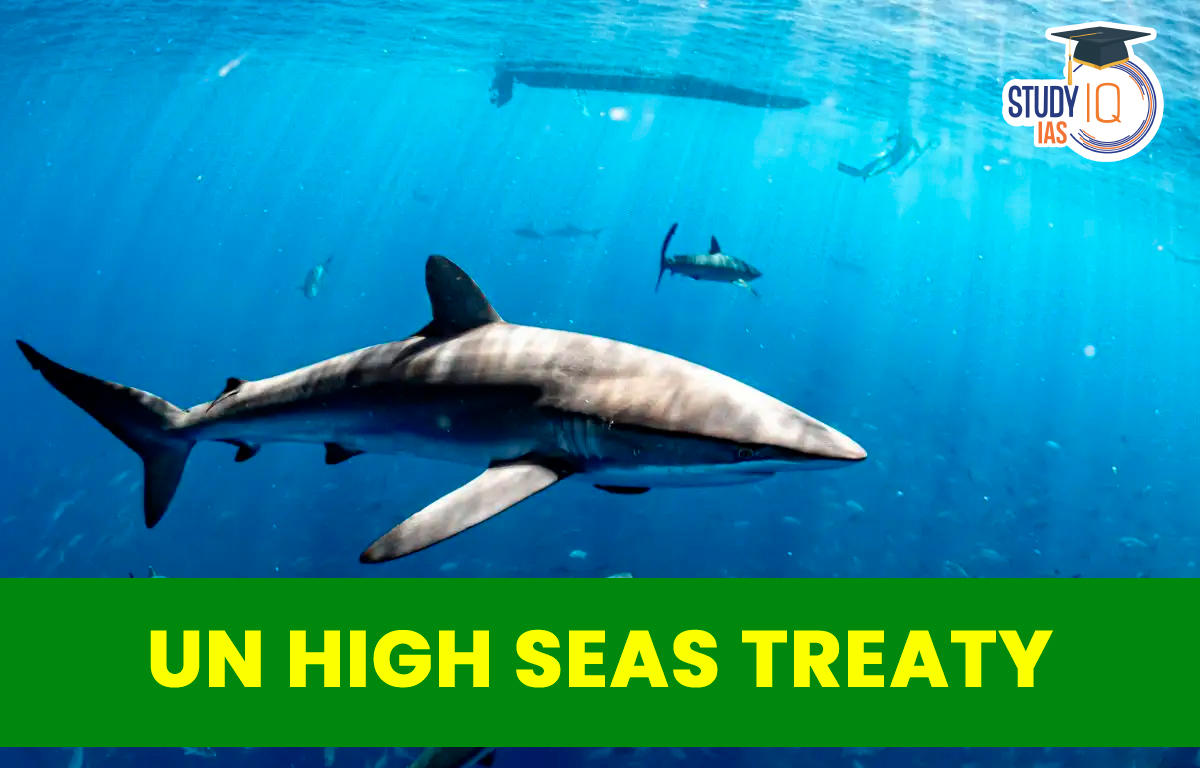Table of Contents
Context: Recently, nations of the world have finalized a new global treaty meant for the conservation and sustainable use of biological resources in the high seas.
What are High Seas?
- High seas are areas of oceans that lie beyond a country’s Exclusive Economic Zone (that extends up to 200 nautical miles (370 km) from the coastline).
- The high seas are also known as international waters or the open ocean.
- No country is responsible for the management and protection of resources on the high seas.
- The high seas comprise 64 per cent of the ocean surface, and about 43 per cent of the Earth.

Why is there a need for a High Seas Treaty?
- Protection of biodiversity: High seas are home to about 2.2 million marine species and up to a trillion different kinds of microorganisms.
- According to the Red List of Threatened Species by IUCN, nearly 10 percent of underwater plants and animals assessed so far are threatened with extinction.
- Regulation of Human Activities: Human activities in the high seas, such as fishing, shipping, and mining, are largely unregulated. This has led to overfishing, habitat destruction, and pollution.
- Addressing Climate Change: The world’s oceans play a critical role in regulating the global climate, storing about one-quarter of the planet-heating carbon dioxide generated by human activities.
- According to NASA, 90% of global warming is occurring in the ocean. The effects of ocean warming include sea level rise, coral bleaching, and intensified hurricanes etc.
- Lack of sufficient protection: Only 1.2% of international waters or high seas are protected, and only 0.8% are identified as “highly protected.”Currently, there is no treaty for conserving the health of vast swathes of the earth’s oceans.
- Equitable Sharing of Benefits: The high seas are a common heritage of humankind, and the benefits derived from their resources should be shared equitably. However, currently, there are no mechanisms in place to ensure that the benefits are shared fairly.

About the UN High Seas Treaty
- The High Seas Treaty is a legally binding international agreement being developed within the framework of the United Nations Convention on the Law of the Sea (UNCLOS).
- The treaty will work as an implementation agreement under the UNCLOS, much like the Paris Agreement works under the UNFCCC.
- Aim of the treaty: It aims to provide a comprehensive legal framework to protect oceans and marine life, particularly in the high seas, which were previously not covered by any such framework.
- BBNJ: The treaty is also known as the agreement on “biodiversity beyond national jurisdictions”, or BBNJ, as the high seas are open ocean areas that are outside the jurisdiction of any country.
- Timeline of the treaty: Although the process of creating the treaty was initiated in 2015, it was postponed due to the Covid-19 outbreak.
- In order to speed up the finalization of the treaty, the European Union established the High Ambition Coalition on BBNJ in 2022.
- Significance: The treaty is significant in achieving the 30×30 target set at UN CBD (Convention on Biological Diversity) COP15 under which the countries agreed to protect 30% of oceans by 2030.
- Key features of the treaty:
| Demarcation of Marine Protected Areas (MPAs) | The treaty will establish a mechanism for demarcation of MPAs to conserve and protect marine environment and biodiversity.
MPAs are where ocean systems, including biodiversity, are under stress, either due to human activities or climate change. These can be called the national parks or wildlife reserves of the oceans. |
| Access and Benefit-sharing Committee | The committee will frame guidelines for the access and sharing of benefits derived from marine genetic resources beyond national jurisdiction. |
| Clearing-House Mechanism (CHM) | The treaty establishes a CHM that will facilitate the sharing of information among member states on the access and benefit-sharing of marine genetic resources beyond national jurisdiction. |
| Environmental Impact Assessments | Signatories will have to conduct environmental impact assessments before the exploitation of marine resources beyond national jurisdiction. |
| Consent from Indigenous Community | The treaty mandates that the marine resources in areas outside national jurisdiction, which belong to indigenous individuals and local communities, can only be accessed with their free, informed consent and or approval and involvement”.
By doing so, the treaty recognizes the important role of indigenous communities in the sustainable management of marine resources. |
| Special fund for developing countries | A special fund will be established as part of the pact, which will be fixed by the conference of parties (COP).
The COP will also oversee the functioning of the treaty. The fund will provide financial support for developing countries to participate in the implementation of the treaty. |
Challenges Associated with the UN High Seas Treaty
- Implementation: Once the treaty is ratified, implementing its provisions will require significant resources and cooperation among states.
- Lack of dispute resolution: The treaty does not provide a clear mechanism for resolving disputes between states operating in the high seas. This could lead to disagreements and potentially undermine the effectiveness of the treaty.
- Enforcement: The treaty lacks a clear enforcement mechanism, and it is unclear how violations of its provisions will be punished. This could make it difficult to ensure compliance with the treaty’s provisions.
About the United Nations Convention on the Law of the Sea (UNCLOS)
- UNCLOS is an international treaty that governs the use and management of the world’s oceans and seas.
- The treaty was adopted in 1982 and entered into force in 1994 and has been ratified by 168 countries (including India).
- Key features of UNCLOS:
- UNCLOS establishes the legal framework for activities in the oceans and seas, including fishing, shipping, and exploration and exploitation of natural resources.
- The treaty recognizes the rights of coastal states over their territorial waters and exclusive economic zones and sets out rules for the delimitation of maritime boundaries between adjacent states.
- The treaty also establishes the International Tribunal for the Law of the Sea (ITLOS), to hear disputes related to the interpretation and application of UNCLOS.
What are the Other Conventions related to Seas?
- Convention on Continental Shelf 1964: It defines and delimits the rights of States to explore and exploit the natural resources of the continental shelf.
- Convention on Fishing and Conservation of Living Resources of the High Seas 1966: It was designed to solve the problems involved in the conservation of living resources of the high seas.
- London convention 1972: Its objective is to promote the effective control of all sources of marine pollution and to take all practicable steps to prevent pollution of the sea by dumping of wastes and other matters.
- MARPOL Convention (1973): It covers pollution of the marine environment by ships from operational or accidental causes. It lists various forms of marine pollution caused by oil, noxious liquid substances, harmful substances in packaged form, sewage and garbage from ships, etc.


 SSC Stenographer 2024 Notification Out a...
SSC Stenographer 2024 Notification Out a...
 IB SA MTS Final Result 2024 Out at mha.g...
IB SA MTS Final Result 2024 Out at mha.g...
 Model Skill Loan Scheme, Eligibility, Re...
Model Skill Loan Scheme, Eligibility, Re...

















